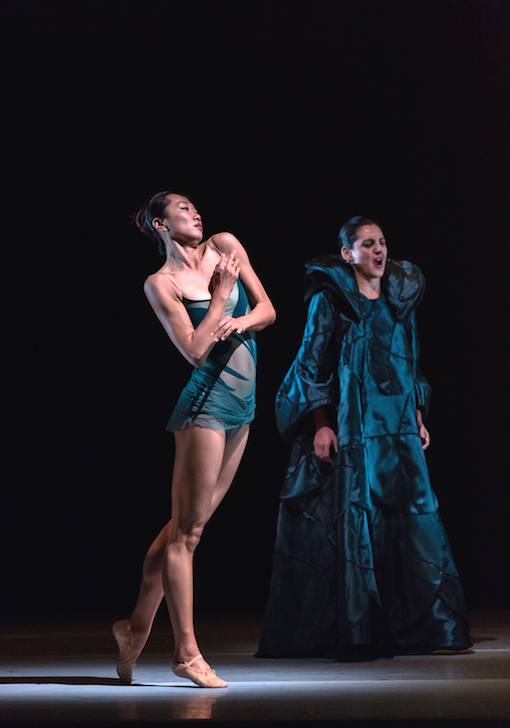
The beauty of winter’s light
Alonzo King’s Lines Ballet presented audiences a warmer side of winter darkness this past weekend with their Fall Season program at Yerba Buena Center for the Arts Theater. The program’s two pieces were collaborations emphasizing the darker palette of musical sound.
The world premiere, Art Songs, was a collaboration with mezzo-soprano Maya Lahyani, who was accompanied by pianist Efrat Levy and violinist Lisa Lee. The notes to the piece remark, “because humans are an expression of the Creative Word, sound has the most potent and immediate effect on us. The ancient rishis of India discovered laws of sound alliance between nature and man.” A rishi being an inspired poet and composer of hymns, the notes referred to the use of poetry, and its medium, the voice, as forms of spiritual expression.
The four songs chosen for this piece are all vocally gorgeous in their poignant lyricism, if not normally categorized as art songs. Each in their way speaks of the pain of betrayal, and human cowardice in the face of love. The opening piece was the alto aria “Erbarme Dich, mein Gott” from Bach’s Matthäus-Passion. Taking place after Peter’s denial of Christ, the aria is a plea for mercy from God. The second song was Bertarido’s aria over his memorial from Handel’s opera, Rodelina, “Dove sei, amato bene”, originally set for male alto and often sung by countertenors. Schumann’s “Stille Tränen” followed, an art song whose title, Silent Tears, speaks for itself. And the set ended with “Dido’s Lament” from Purcell’s wonderful opera, the song Dido sings to her sister before committing suicide. “Remember me,” she exhorts “but ah! forget my fate.”
None of these are sprightly songs, and their pathos is emphasized by the rich colors of the mezzo voice. Lahyani stood amidst the dancers, garbed in miles of deep ultramarine fabric that luminesced like thick silk satin, giving her voice and her physical presence on stage visual substance, as if she were the embodiment of transcendent sorrow. The gorgeous outfit, reminiscent of a medieval gown, the hood lined in black, was realized by courturier Colleen Quen. The dancers were dressed in the barest of costumes, sheer and with less fabric than a handkerchief.
The songs’ somber emotional timbre was also coded into the dance, in choreographer Alonzo King’s use of his dancers’ bodies as they moved through space. Many of the steps in the opening song, which was danced by the company, were set close to the floor, in deep pliés that sprang into extensions, or in individual dancer’s collapse into crouching positions on the floor.
The second song, Handel’s strange theatrical device of a man believed dead singing over his grave to his beloved wife, was danced with Meredith Webster in dazzling white. Although Webster moved into Ballet Master position in 2014, she still holds her own as a thrilling and dynamic dancer. She was supported in her solo work by the duet of Courtney Henry and Madeline DeVries. Although these sections were danced “close to the ground” the urgency of the movement was never lost.
Schumann’s Romantic song was danced by the company in a series of breath-taking duets. And the entire piece ended with a complex and intimate duet between Yujin Kim and Michael Montgomery. The mezzo’s presence as a mediating force was especially clear in this duet, in which the three performers moved like the points in a series of triangulations, the intention of which was to find the physical point of an emotional center between three people. Love once lost becomes a kind of black hole of sorrow, drawing in a history of connection and need.
The second piece on the program was Meyer, which had its premiere in 2013. Meyer was the company’s collaboration with Edgar Meyer, the noted classical bassist and composer. Settling again in the darker resonances of music, the seven-part piece often focused on particular dance forms – turns, extensions, jumps – as series of repeating motifs. The brilliant set design by Jim Doyle was composed of streams of water, which fell from above the stage to the floor, and were illuminated by gold light, so they appeared like glittering cascades of molten metal.
Lines Ballet once again coupled refined and elegant presentations with superlative dancing and endlessly dynamic choreography. A match made in heaven.
– Jaime Robles
Photo: Mezzo-soprano Maya Lahyani and dancer Yujin Kim perform in the world premiere of Alonzo King’s Lines Ballet “Art Songs,” at Yerba Buena Center for the Arts. Photo by Quinn B. Wharton.
